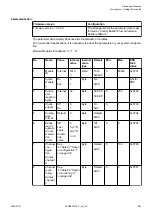
The internal power supply voltage for the module's circuitry is carried out via the I/O bus
(provided by a communication interface module or a CPU). Thus, the current consumption from
24 V DC power supply at the terminals L+/UP and M/ZP of the CPU/communication interface
module increases by 2 mA per AO523.
The external power supply connection is carried out via the UP (+24 V DC) and the ZP (0 V DC)
terminals.
WARNING!
Removal/Insertion under power
Removal or insertion under power is only permissible under conditions
described in Hot Swap chapter
Chapter 1.6 “I/O modules” on page 142
The devices are not designed for removal or insertion under power when Hot
Swap conditions do not apply. Because of unforeseeable consequences, it is
not allowed to plug or unplug devices with the power being ON.
Make sure that all voltage sources (supply and process voltage) are switched
off before you
–
connect or disconnect any signal or terminal block
–
remove, mount or replace a module.
Disconnecting any powered devices while energized in a hazardous location
could result in an electric arc, which could create a flammable ignition resulting
in fire or explosion.
Make sure that power is removed and that the area has been thoroughly
checked to ensure that flammable materials are not present prior to proceeding.
The devices must not be opened when in operation. The same applies to the
network interfaces.
NOTICE!
Risk of damaging the PLC modules!
Overvoltages and short circuits might damage the PLC modules.
–
Make sure that all voltage sources (supply voltage and process supply
voltage) are switched off before you begin with operations on the system.
–
Never connect any voltages or signals to reserved terminals (marked with
---). Reserved terminals may carry internal voltages.
Generally, analog signals must be laid in shielded cables. The cable shields
must be grounded at both sides of the cables. In order to avoid unacceptable
potential differences between different parts of the installation, low resistance
equipotential bonding conductors must be laid.
Only for simple applications (low electromagnetic disturbances, no high require-
ment on precision), the shielding can also be omitted.
The following figure shows the connection of the module:
Device specifications
I/O modules > Analog I/O modules
2022/01/31
3ADR010278, 3, en_US
488













































